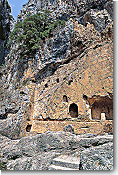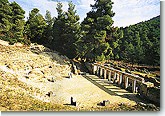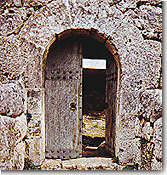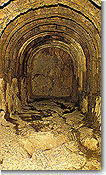





     |
|
|
|
It is certain, for the Archaic period, that oracles at most |  |
But apparently there was another method at Dodona more important and probably older: prophecy from chance sounds or from the rustling of the Sacred Oak and sounds from the bronze cauldrons that adorned it. These sounds, known as kledones or phemai, were interpreted by the priests. An equivalent tradition is known for the shrine of Apollo Ismenius at Thebes. In the Achaean city of Pharai there was a statue of Hermes in the marketplace. A person interested in consulting the god would approach it and whisper a question into its ear. After this, he would retire to a distance, holding his hands over his ears, and taking them away only once he had left the marketplace. Whatever words he first heard were the oracle of the god.
  |
Another special category of oracles was those where the divine oracle was revealed to the worshipper in a dream. All of these were connected with curing and with therapeutic deities or heroes. The worshipper had to fall into a slumber (egkoimese) in a holy place, precinct or sanctum (abaton), and whatever dreams he had revealed to him the outcome of his illness. This was how the Amphiareum at Thebes and the Amphiareum at Oropus worked. It was a method common at many shrines of Asclepius too, the best-known of them being, of course, Epidaurus. There the worshippers lay down in the enkoimeterion or sanctum and waited for the godsent dream. Very often, indeed, the experience of the dream was at the same time a cure. Analogous was the functioning of the dream oracle at Oetylus in Laconia; the Charonian cave, sacred to Demeter and her Daughter, at Nysa in Caria; and the cave oracle of Trophonius at Lebadea. At the last-named, the worshipper was subjected to a series of rituals the climax of which was the nocturnal crawl (eiserpyse) into the cave's narrow, labyrinthine passages. On emerging, the worshipper would tell the priests what he had seen and heard. They provided an interpretation, though in reality what had most effect on the worshipper was the his emotional disturbance from the test. |
The necyomanteum or psychopompeum worked on the same principle. There the worshippers, having sacrificed to the chthonian gods, invoked the shades of the dead, from whom they would receive an oracle. The most celebrated necyomanteum was at Ephyra in Thesprotia, not far from the mouths of Acheron. |
 |
 |
|
| |
|
Note: Click on a picture for a brief description. | |